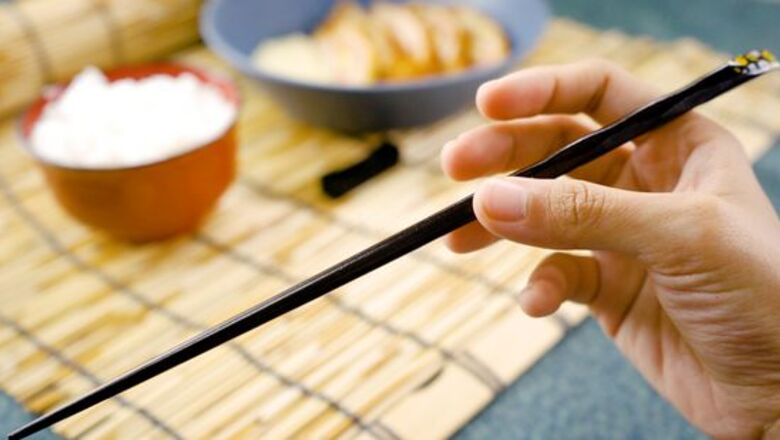
views
- Hold your chopsticks about a third of the way down from the thicker end.
- Rest the bottom chopstick on the side of your ring finger and the crook of your thumb.
- Set the top chopstick directly above the bottom one and hold it with your pointer and middle finger like a pen.
- Use your thumb as a fulcrum to move the top chopstick up and down to grab food while keeping the bottom chopstick still.
Positioning Chopsticks in Your Hand
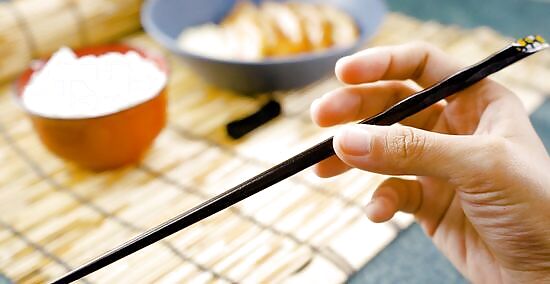
Place the first chopstick in the crook of your thumb. The tapered end of the first chopstick rests on the side of your ring finger, while the thicker top is cradled in the crook of your thumb. About a third of the chopstick extends above the crook of your thumb—more than that, and you'll have a hard time controlling your chopsticks to eat. If your chopsticks have a design on the thick end, this can help you figure out how far down to hold them. Just hold the chopstick so that the design ends just above the crook of your thumb.
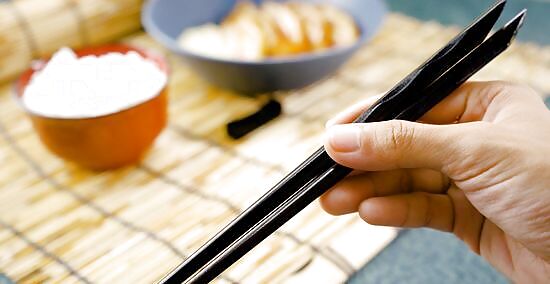
Rest the second chopstick on top of the first and hold it like a pen. Take your second chopstick and line it up with the first so you're gripping them evenly. The second chopstick rests on the side or pad of your middle finger (whichever is more comfortable for you). The thicker part of the second chopstick also sits in the crook of your thumb, but it's higher up—closer to the first knuckle of your pointer finger. Press your pointer finger on top of the second chopstick, just as you would if you were holding a pen. This is how you'll open and close your chopsticks to grasp food and bring it to your mouth to eat.
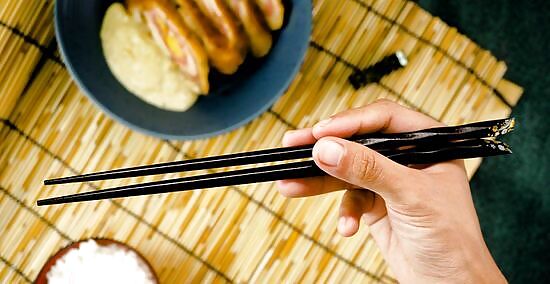
Keep the first chopstick still at all times. This is one of the most important parts about eating with chopsticks—that first chopstick, the one on the bottom, never moves. Manipulate the second, or top, chopstick up and down to open and close your chopsticks. Practice just closing the tips together to get used to the amount of pressure you need. If the tips cross, you're using too much pressure—easy does it!
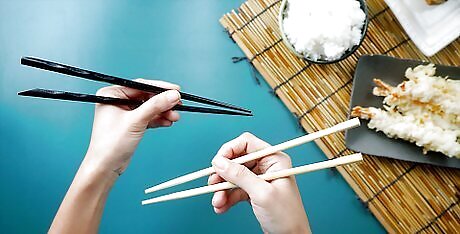
Use wooden or bamboo chopsticks until you get the hang of it. Wooden and bamboo chopsticks are sturdy and don't get slippery, which makes them much easier for beginners to use. Once you gain confidence in your ability to handle chopsticks, you can graduate to plastic or stainless steel chopsticks if you want. Japanese chopsticks are typically lacquered, which can make it harder for you to pick up slippery things until you've developed the dexterity to apply the correct pressure. Korean chopsticks are traditionally stainless steel. These chopsticks have the reputation for being the hardest to control, so save them until you really feel comfortable.

Try training chopsticks if you're having a hard time. Training chopsticks are connected at the top so they're easier to control. They're meant for kids, but there's no shame in using them as an adult! If you find using them slightly embarrassing, just save them to practice by yourself at home. Eating snack foods with chopsticks is a good way to build dexterity until you can graduate to "real" ones.
Eating with Chopsticks
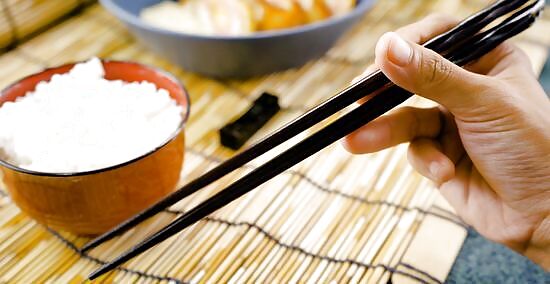
Lift your pointer and middle fingers together to open your chopsticks. Since you're holding this chopstick like you would a pen or pencil, think about drawing a straight line. This is how you open and close your chopsticks. Remember to keep the bottom chopstick still while you're moving the top one. Hold it firmly enough in the crook of your thumb that it won't slide down when you move your other fingers.

Close your chopsticks around a single piece of food. Now comes the fun part! Draw an imaginary line upward to open your chopsticks over a piece of food, then draw the imaginary line downward to close your chopsticks around the food. Make sure you've got enough grip to keep hold of the food as you lift it and bring it to your mouth. Start with something about the size of a piece of sushi and gradually move to smaller things as you build your dexterity.
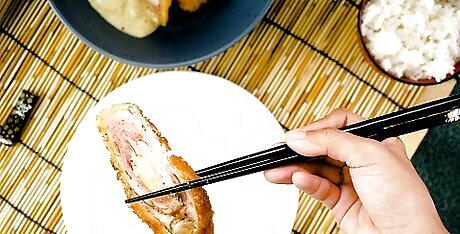
Maintain gentle pressure to secure the food and bring it to your mouth. Grip tightly enough that you have control over the food, but not so tightly that you squeeze or crunch it. The specific amount of pressure you need varies depending on the food's density and texture. If you're having a tough time figuring out how much pressure you need, practice with small objects. For example, you might try picking up a cotton ball without squishing it.
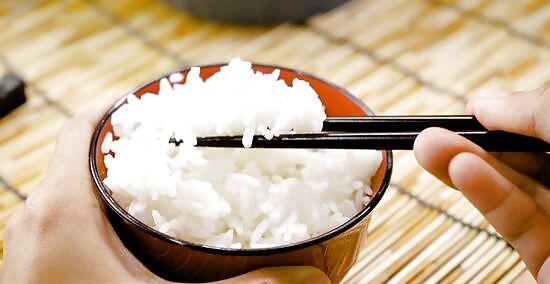
Turn your chopsticks to the side and scoop to eat rice. Traditional Asian dishes are served with the idea of eating with chopsticks in mind. But what about the rice? Just turn your wrist so the hand you're holding your chopsticks with is sideways, like it would be if you were going to shake someone's hand. Then, stick your chopsticks under the rice to scoop some up and eat it. Japanese rice, in particular, is usually sticky enough that it will stay in a clump and not fall through the gap in your chopsticks. But it's still a good idea to keep them pretty close together.
Following Chopsticks Etiquette
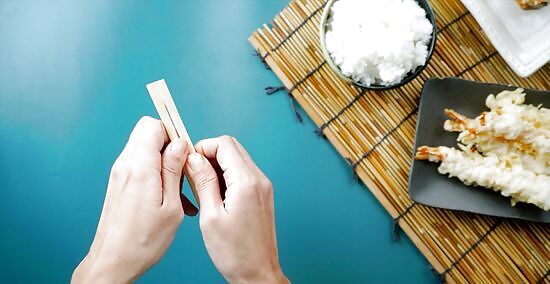
Take disposable chopsticks out of the packaging neatly. Tear off the top of the paper to extract your chopsticks (they're called waribashi), then leave the paper flat to the side of your plate. Snap them apart and you're ready to eat. Do not rub them together. If you had cheep, poorly made waribashi, you might rub them together to remove splinters. But when you do it a restaurant, you're telling the restaurant you think their chopsticks are cheap and poor quality, which is definitely an insult. If you do happen to see splinters, pull your chopsticks under the table and rub them discretely. You could also simply put them back in the sleeve and ask for more. When you're done eating, slip your chopsticks back in the paper sleeve so they can be neatly disposed of. If you're taking a break, you can also use the paper sleeve as a chopsticks rest.
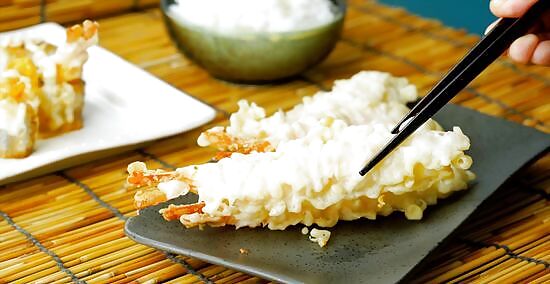
Use both chopsticks at the same time to grab and eat food. Think of the chopsticks as a single unit—you can't use one without the other. As tempting as it might be to stab food with the pointed end of a single chopstick to pick it up and eat it, this is not the way (and you'll definitely get some strange looks). In some Asian cultures, it's considered rude to stir your food with your chopsticks or use them to tear food into smaller pieces. Asian food is prepared with the understanding that it will be eaten with chopsticks, so you're usually not going to have to cut it into smaller pieces. If you do pick up a piece that's bigger than you feel comfortable putting in your mouth at once, you're totally allowed to take multiple bites off of it. Just keep it in your chopsticks the whole time—don't take a bite off of it and then return it to your plate.
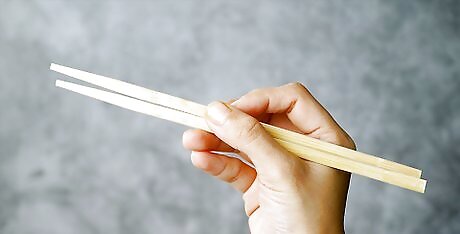
Avoid pointing or gesturing with your chopsticks. It would be considered rude to point at someone with your knife or fork, and it's the same with chopsticks. Generally, refrain from doing anything with your chopsticks other than eating food. If you're between courses or not eating, set them down on the chopsticks rest or on your napkin beside your plate so you won't be tempted to fiddle with them.
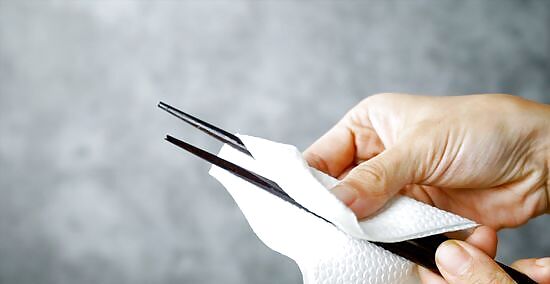
Wipe the tips of your chopsticks with your napkin. You don't want your chopsticks to drip, so wipe them off before you set them down on the chopsticks rest. Don't lick or suck them to get the liquid off—that's considered a bit gross. Chopsticks are intended to elegantly convey food to your mouth. You'll seem more refined if your chopsticks touch your actual mouth as little as possible.
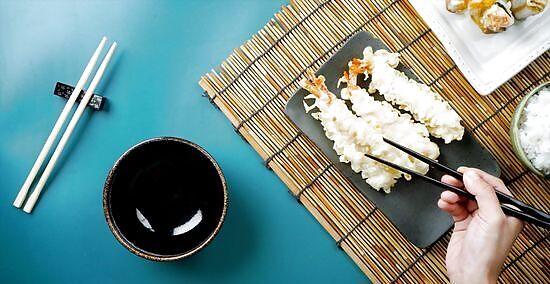
Get food from communal plates with serving chopsticks. Family-style dining is common in many Asian cultures. Each person at your table will have a small plate in front of them, then the food will be served on large platters in the middle of the table for everyone to eat off of. Use the larger serving chopsticks to take the food off the platter and put it on your personal plate. Then, use your personal chopsticks to eat the food. If you find serving chopsticks difficult to work with because of their size, work around it. Just wait until someone else is getting something, then hold up your plate so they can get you some as well. If you don't have serving chopsticks, Hong Kong and Cantonese etiquette allow you to turn your personal chopsticks backward to get food from communal plates. Since that end hasn't been in your mouth, it's considered more sanitary. Don't transfer food with your chopsticks to someone else's chopsticks. This is reminiscent of a funeral rite, so it's a bad omen to do it at the table while eating.
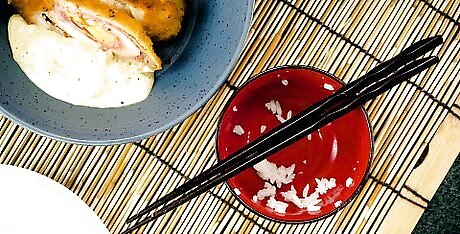
Lay your chopsticks across your plate or bowl when you are done eating. This is basically the same signal you give if you lay your knife and fork across your plate. People will assume you're completely done eating and, if you're at a restaurant, the server will likely take away your plate. If you're between courses or taking a break, use the chopsticks rest or place your chopsticks beside your plate or just along the edge. That way, no one will assume you're done. Don't leave your chopsticks standing straight up in a bowl of rice, either—especially not in Japan! This is a funeral ritual, and anything that invokes death or funerals is considered bad luck and is a big no-no.













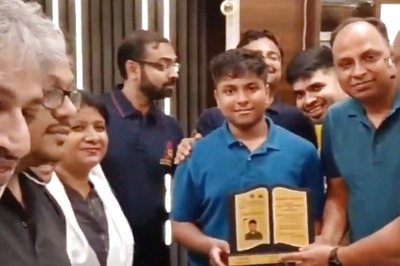
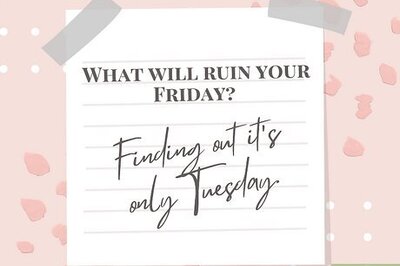



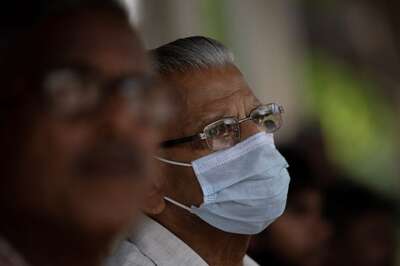
Comments
0 comment